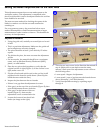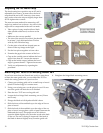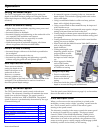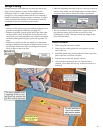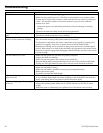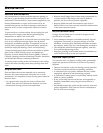
Crosscutting and Trimming
No other saw on the market can outperform a Festool for
splinter-free, fine crosscutting. With other saws, the problem
is two-fold; getting a straight cut, and achieving a splinter-
free cut. The TS 55 handles these problems effortlessly.
18 TS 55 EQ Circular Saw
Tips for Successful Crosscutting
► Use the correct blade for the cut.
► Crosscutting fine veneered wood should use the fine
crosscut blade. The Alternate-Top-Bevel teeth will slice
the wood fibers best, with virtually no chipping.
► Crosscutting soft lumber, or lumber-core veneers should
use the combination blade. With fewer teeth than the
fine crosscut blade, this blade will be more aggressive
for cutting, yet still provide good chip-free cutting.
► Crosscutting thick hardwood lumber, and difficult to cut
lumber should use the coarse crosscut blade. The coarse
tooth-count of this blade provides very aggressive
cutting of difficult material, but won’t provide as
smooth of a finish as the finer blades.
► Cutting plastic-veneer countertops or solid surface
materials should use the fine laminate blade. The Triple-
Chip-Grind of this blade lasts longer in hard materials
and reduces chipping in man-made materials. The
triple-chip-grind will provide good cuts in wood
veneers, but not as good as the alternate-top-bevel fine
crosscut blade.
► For small offcuts, overhang the workpiece from a work
table or saw horses (as shown below). For larger offcuts,
support both the primary piece and the offcut.
► If the offcut is reusable, use the outrigger splinter guard to
prevent chipping.
► Make sure the workpiece is secure. The lightweight door
shown in the example below would slide on the table if
not clamped down.
► Make sure the guide rail is secure if it can move during the
cut. In the example below, starting the cut with the saw
behind the workpiece can cause the guide rail to tip up
and move. (The guide rail clamps are below the guide rail,
and not visible.)
► Don’t start the cut by plunging the saw into the wood, as
this can lead to tearout at the bottom-back of the sawblade.
Start the cut with the blade down and behind the
workpiece, and advance the saw forward into the cut.
► Setting the blade depth too shallow (just barely
penetrating the underside of the workpiece) can cause
tearout on the underside of the cut.




